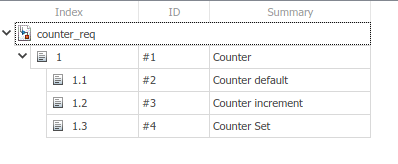将自定义编写的 MATLAB 脚本的结果集成为测试
在此示例中,您将需求链接到 MATLAB® 脚本。需求编辑器中的验证状态反映了测试结果。此示例执行 链接到测试脚本 中描述的步骤。此示例使用名为 counter_req.slreqx 的需求集文件和名为 runmytests.m 的 MATLAB 脚本,该脚本为 Counter 中的 Counter.m 类运行测试。测试脚本包含自定义方法,将结果以 TAP 格式写入名为 results.tap 的文件。
注册自定义文档接口
在创建链接之前,您需要注册自定义文档接口。在需求编辑器中打开需求文件 counter_req.slreqx:
reqSet = slreq.open('counter_req.slreqx');
注册特定于外部测试文件的自定义文档接口。
rmi register custom_mymscripttap
GetResultFcn 函数中的自定义逻辑找到与测试用例相对应的测试文件并从该测试文件中获取结果。
如果注册命令返回警告,则必须取消注册该文件并再次运行该命令。要取消注册该文件,请输入 rmi unregister custom_mymscripttap。
创建链接
制作包含外部测试属性的结构。要创建链接,请在命令提示符下输入:
externalSource.id = 'counterStartsAtZero'; externalSource.artifact = 'runmytests.m'; externalSource.domain = 'custom_mymscripttap';
与该链路相关的需求其 SID 设置为 2。要查找与链接相关的需求,请输入:
requirement = reqSet.find('Type','Requirement','SID',2);
要创建链接,请输入:
link = slreq.createLink(requirement, externalSource);
此命令创建测试用例 counterStartsAtZero 与 SID 为 2 的需求之间的链接。在需求编辑器中,链接出现在详细信息窗格的链接下。

为了避免结果过时,请确保结果文件的时间戳比链接创建的时间戳新。打开结果文件,在文件中进行虚拟更改并再次保存以获取最新的时间戳。
查看验证状态
要查看验证状态,您需要先更新需求集的验证状态。在 MATLAB 命令提示符下,键入:
reqSet.updateVerificationStatus;
要在需求编辑器中查看验证状态列,请在视图部分中,确保已选中列 > 验证状态。更新后,获取需求的验证状态:
status = reqSet.getVerificationStatus;
需求编辑器显示通过或失败的整个需求集的验证状态。

counterStartsAtZero 的需求的验证状态已完全验证。打开需求编辑器查看验证状态:
reqSet = slreq.open('counter_req.slreqx');验证状态显示,三项测试中,有一项测试通过。点击“刷新”可查看需求编辑器中需求的验证状态。

取消注册自定义文档接口。
rmi unregister custom_mymscripttap